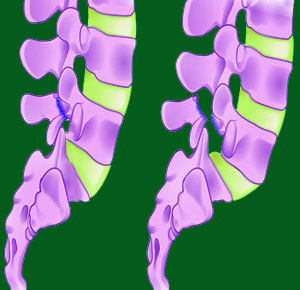
Spondylolisthesis symptoms are only present in a minority of severe grade 3 or grade 4 vertebral slippage conditions. Most mild to moderate listhesis is asymptomatic. When symptoms do exist, they might include not only localized back or neck pain, but also a diversity of neurological expressions, depending on the nature of the causative process.
Spondylolisthesis is known to be a very dramatic condition in terms of structural presentation. Fortunately, symptoms rarely match the visual profile, except in the very worst instances of vertebral migration. When symptoms are present, however, they can be difficult to treat conservatively and may therefore require invasive treatment using one or more surgical techniques to fully resolve.
This resource section explores the typical symptomatic expressions of a range of listhesis conditions. We will detail why most cases of vertebral slippage are not symptomatic, as well as why some cases can become painful and even debilitating.
Does Spondylolisthesis Produce Pain?
Research shows that back pain is more prevalent in people with spondylolisthesis than in people who do not demonstrate vertebral migration. This makes listhesis very credible as a source of pain. However, virtually all cases of spondylolisthesis that are symptomatic fall into the grade 3 and 4 categories. These are the rarest examples of vertebral slippage, accounting for less than 10% of the total diagnosed patient population. Over 90% of listhesis patients are either category 1 or 2, with the majority being classified as low grade 1.
Given these factual statistics, it is safe to say that grade 3 and 4 listhesis stand a fair chance of being symptom-producing conditions. However, it is not fair to say that these more severe grades of listhesis are inherently painful, as many patients with clinically significant cases do not express any symptoms. Meanwhile, grade 1 and 2 cases of listhesis are generally considered innocuous structural atypicalities, yet in extremely rare instances, it is conceivably possible that some of these cases might be symptomatic, as well.
One of the more important questions to ask is whether YOUR listhesis produces pain or not. Remember that many listhesis conditions are mistakenly blamed for pain when the real cause resides elsewhere. It is always best to verify the condition as being definitively pathological before even considering any type of treatment, in order to improve the chances for successful therapy and symptomatic resolution.
Spondylolisthesis Symptom Topics
Below we examine the various types of symptomology that might be directly caused by spondylolisthesis, as well as pain issues that might be created by a combination of contributors, including vertebral migration. As each new essay is published, it will be shared in the section below:
Spondylolisthesis pain is an unusual presentation of the most clinically severe types of listhesis. When pain exists, it can take many forms and become a real problem for patients.
Acute spondylolisthesis describes severe, sudden presentations of pain that might occur for known or unknown reasons.
Chronic spondylolisthesis describes long-term presentations of pain that are related to structural change over many years.
Spondylolisthesis flare-ups can occur due to injury or idiopathic reasons. Flare-ups are what cause many patients to seek surgical correction of their spinal issues.
Spondylolisthesis lower back pain is the most common location for symptoms to exist, since listhesis is most often seen at L5 or L4.
Spondylolisthesis stiff back muscles are a common collateral side effect of some varieties of vertebral migration, regardless of whether the condition is painful or not. Similarly, spondylolisthesis tired muscles can occur when the lumbar soft tissue anatomy must work extra hard to support a less stable spinal column.
Spondylolisthesis foot drop is a serious consequence of neurological compression in the spinal cord or in the lumbar nerve roots.
Spondylolisthesis incontinence is another devastating effect that can be created by neurological compression due to vertebral slippage.
Spondylolisthesis sexual dysfunction might exist concurrently or instead of incontinence, as the structures involved are very similar.
Spondylolisthesis sciatica is one of the most common of all symptomatic expressions, and usually signifies the presence of one or more compressive neuropathy issues between nerve roots L4 to S3.
Spondylolisthesis weakness can occur in the back itself or in any muscular tissues that are suffering from innervation problems as a result of vertebral migration.
Spondylolisthesis gait changes can sometimes be detected by clinicians and may provide clues about symptomatic activity or even the causative process.
Spondylolisthesis posture may also change in relation to an atypical vertebral slippage condition, especially when traditionally located at L4 or L5.
You can prevent, manage and cure painful symptoms using our proven Cure Back Pain Forever Program and its proprietary 3 tier approach to pain relief.
Warnings on Spondylolisthesis Symptoms
Misdiagnosis is a huge scale problem in the dorsalgia treatment sector. So many structural abnormalities are unfairly blamed for creating pain and subsequently treated, yet the pain endures. Of course this is logical, given an incorrect diagnosis and treatment targeting the wrong origin of pain.
Fortunately, the incidence of misdiagnosis is less frequent with listhesis patients than with many other back pain diagnoses, such as degenerative disc disease, herniated discs, facet syndrome and general osteoarthritis conditions. However, a fair number of spondylolisthesis patients are still mistakenly diagnosed as suffering from painful vertebral slippage when their symptoms are not sourced by the change in normal vertebral position. Be wary of this occurrence, as it might place you on the path to contraindicated care and possibly, unnecessary surgery. It is best to seek expert diagnostic evaluation from a listhesis specialist and always get more than one opinion on both the prognosis and treatment recommendations for your specific condition.
Spondylolisthesis > Spondylolisthesis Symptoms



